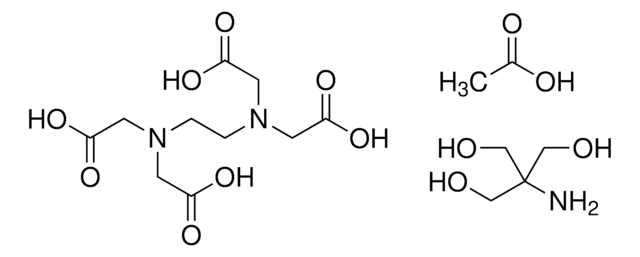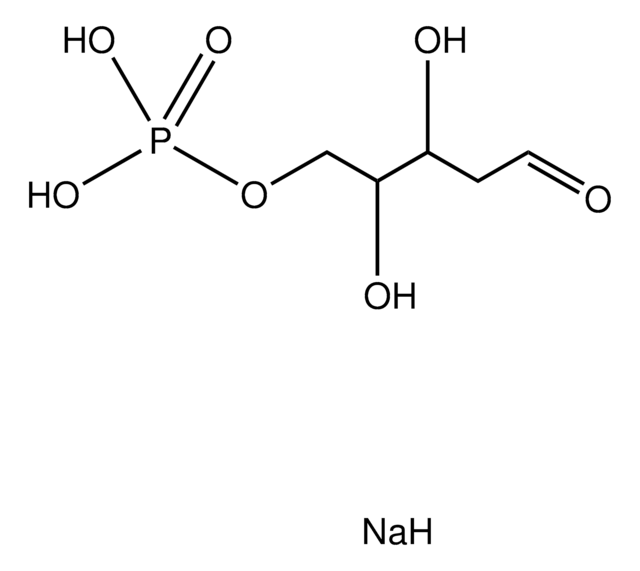T1258
Trizma® acetate
≥99.0% (titration)
Synonym(s):
TRIS acetate salt, Tris(hydroxymethyl)aminomethane acetate salt
Sign Into View Organizational & Contract Pricing
All Photos(3)
About This Item
Linear Formula:
NH2C(CH2OH)3 · CH3COOH
CAS Number:
Molecular Weight:
181.19
Beilstein:
3702918
EC Number:
MDL number:
UNSPSC Code:
12161700
PubChem Substance ID:
NACRES:
NA.25
Recommended Products
Assay
≥99.0% (titration)
form
crystalline powder
pH
6.0-7.0 (0.1 M in water, high purity)
solubility
water: 0.5 M, clear, colorless
SMILES string
CC(O)=O.NC(CO)(CO)CO
InChI
1S/C4H11NO3.C2H4O2/c5-4(1-6,2-7)3-8;1-2(3)4/h6-8H,1-3,5H2;1H3,(H,3,4)
InChI key
PIEPQKCYPFFYMG-UHFFFAOYSA-N
Looking for similar products? Visit Product Comparison Guide
Related Categories
Application
Trizma® acetate has been used:
- in the adenosine triphosphate (ATP) assay to neutralize the pH to 7.7 of the oocyte supernatant
- in cell wall isolation to remove proteins and membranes from the cell walls of plants
- as a component of DamID buffer, lysis buffer for cell sorting and lysing
Legal Information
Trizma is a registered trademark of Merck KGaA, Darmstadt, Germany
Storage Class Code
11 - Combustible Solids
WGK
WGK 3
Flash Point(F)
Not applicable
Flash Point(C)
Not applicable
Personal Protective Equipment
dust mask type N95 (US), Eyeshields, Gloves
Choose from one of the most recent versions:
Already Own This Product?
Find documentation for the products that you have recently purchased in the Document Library.
Customers Also Viewed
Máté Borsos et al.
Nature, 569(7758), 729-733 (2019-05-24)
In mammals, the emergence of totipotency after fertilization involves extensive rearrangements of the spatial positioning of the genome1,2. However, the contribution of spatial genome organization to the regulation of developmental programs is unclear3. Here we generate high-resolution maps of genomic
Masanobu Yamamoto et al.
ChemSusChem, 13(17), 4400-4408 (2020-07-22)
Increases in coniferaldehyde content, a minor lignin residue, significantly improves the sustainable use of plant biomass for feed, pulping, and biorefinery without affecting plant growth and yields. Herein, different analytical methods are compared and validated to distinguish coniferaldehyde from other
Our team of scientists has experience in all areas of research including Life Science, Material Science, Chemical Synthesis, Chromatography, Analytical and many others.
Contact Technical Service










